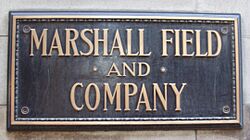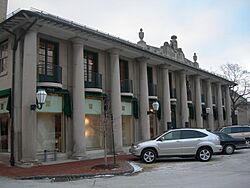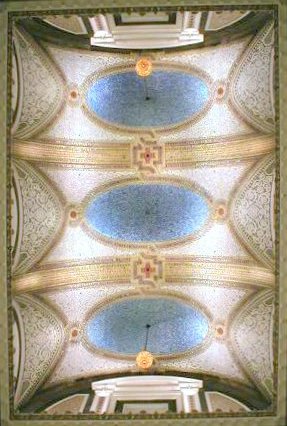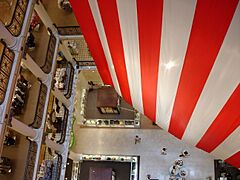Marshall Field's facts for kids
 |
|
| Industry | Retailing |
|---|---|
| Fate | Acquired by Federated Department Stores, converted to Macy's |
| Successor | Macy's |
| Founded | 1852 |
| Defunct | September 9, 2006 |
| Headquarters | Chicago, Illinois, |
|
Key people
|
|
| Parent |
|
| Subsidiaries |
|
Marshall Field & Company, often called Marshall Field's, was a famous department store in Chicago, Illinois. It started in the 1800s and grew into a huge chain of stores. In 2005, another company called Macy's bought it.
The main Marshall Field's store, located on State Street in downtown Chicago, is a very important historical building. Today, it's known as Macy's on State Street and is one of Macy's biggest stores.
Contents
The Story of Marshall Field's
How It All Began
The story of Marshall Field's began in 1852. That's when a man named Potter Palmer opened a dry goods store in Chicago. Dry goods stores sold fabrics, clothing, and other household items.
In 1856, a 21-year-old named Marshall Field moved to Chicago. He started working at a large dry goods company called Cooley, Wadsworth & Company. By 1860, Field and another worker, Levi Leiter, became junior partners in the company.
Later, in 1865, Field and Leiter teamed up with Potter Palmer. Palmer was not feeling well and wanted to sell his successful business. So, their new store was called Field, Palmer, Leiter & Company. Palmer helped them with money at first.
After two years, in 1867, Palmer left the business to focus on his real estate. His brother also left. The store was then renamed Field, Leiter & Company. In 1868, Palmer convinced Field and Leiter to rent a new, fancy six-story building he had built. People called it the "Marble Palace" because it was made of expensive marble.
Facing the Great Chicago Fire
When the Great Chicago Fire started on October 8, 1871, it was a huge disaster. Company leaders quickly decided to save as much valuable merchandise as possible. They loaded wagons and took goods to Leiter's home, which was away from the fire.
Employees worked hard through the night. They used steam-powered elevators to move important records and goods to safety. Even when the gaslights went out, they kept working by candlelight. They tried to use the store's fire hoses to wet the roof. But then the city's water supply stopped.
The store burned down completely. However, because of the employees' amazing efforts, so much was saved. The store was able to reopen in just a few weeks! They used a temporary location, a horse-streetcar barn. Six months later, in April 1872, Field & Leiter opened in another building that hadn't burned.
Growing Bigger and Better
Two years later, in 1873, Field and Leiter returned to their old spot on State Street. They opened a new five-story store. This store was expanded in 1876, but then it burned down again in 1877!
But Field and Leiter didn't give up. They quickly opened a new temporary store. By April 1879, they were back at their traditional location on State and Washington Streets for good.
In 1881, Marshall Field bought out Levi Leiter. The business was renamed "Marshall Field & Company". Leiter retired to focus on his many real estate investments.
In 1887, a huge seven-story building opened. It was called the Marshall Field's Wholesale Store. This part of the business sold goods in large amounts to smaller stores across the country. It was much bigger than the retail store at the time. The money made from the wholesale division made Marshall Field one of the richest men in Chicago.
A Store for Everyone
After Leiter left, the retail store became more important. It was known for its beautiful building and fancy goods. In 1887, Harry Gordon Selfridge was put in charge of the retail store. He helped it become a modern department store.
In 1892, famous architect Daniel H. Burnham designed a new building for the store. This was in time for the World's Columbian Exposition in 1893, which brought many visitors to Chicago. The "Annex" building opened in August 1893. In 1897, the old store was rebuilt and made taller. That's when one of Marshall Field's famous Great Clocks was put on the corner of State and Washington Streets.
In 1901, Marshall Field & Company became a public company. More new buildings were added, making the store even bigger. By 1906, a third new building opened.
Marshall Field passed away in 1906. On the day of his funeral, all the stores in Chicago closed to honor him. The company's new president was John G. Shedd. He was called "the greatest merchant in the United States."
Under Shedd's leadership, Marshall Field & Co. continued to grow. In 1907, a new building opened with a stunning ceiling made of Louis Comfort Tiffany glass. It had over 1.6 million pieces! At this time, Marshall Field's was briefly the "world's largest department store."
By 1914, the store covered an entire city block! It had many restaurants and lounges, becoming a popular place for people to visit.
In 1913, there was an investigation about the low wages of women working in department stores. Many women worked at Marshall Field's as sales clerks. They were trained in good manners and knew a lot about the products. These women were very important to the store's success. However, their wages were very low, often just $5 to $8 a week. This was not enough to live on, even back then.
First Branch Stores and Frango Mints
After Shedd retired, James Simpson became president. He helped expand the retail side of the business. The first Marshall Field's branch store opened in Lake Forest, Illinois in 1928. Soon after, stores opened in Evanston, Illinois and Oak Park, Illinois.
In 1929, Marshall Field's bought Frederick & Nelson, a department store in Seattle, Washington. Frederick & Nelson was famous for creating Frango mints. These delicious mints later became very popular in Chicago too, made right in the State Street store's candy kitchen.
Marshall Field & Company became a public company in 1930, during the Great Depression. The company built a huge new building called the Merchandise Mart for its wholesale business. When it opened in 1930, it was the largest building in the world! However, the Great Depression made it hard for the wholesale business, and it was eventually closed by 1936.
Expanding to the Suburbs
After World War II, Marshall Field's started opening stores in the suburbs. This was a smart move because many customers were moving out of the city. In 1950, they opened a store in Park Forest Plaza.
More suburban stores followed, like in Skokie, Illinois (1956), Wauwatosa, Wisconsin (1959), Oak Brook, Illinois (1962), and Calumet City, Illinois (1966).
Marshall Field's also expanded to other states. They bought The Crescent in Spokane, Washington in 1962 and Halle Brothers Co. in Cleveland, Ohio in 1970. They continued to open more stores in Illinois and even in Texas in 1979.
In the early 1980s, Marshall Field's opened more stores in Illinois and a store in Dallas, Texas.
New Owners and a Big Change
In 1982, a British company called B.A.T. bought Marshall Field & Co. Marshall Field's joined other stores like Saks Fifth Avenue and Kohl's under this new owner. Field's continued to open new stores, including in Houston and San Antonio, Texas.
However, in 1986, B.A.T. started selling off its retail businesses. Marshall Field's was sold to Target Corporation in 1990.

In 2001, Target Corporation changed the names of its other department stores, Dayton's and Hudson's, to Marshall Field's. This meant Marshall Field's stores were now in new areas.
In 2004, Target Corporation sold Marshall Field's to May Co.. People hoped this would help Field's become even more upscale. But in 2005, another company called Federated Department Stores, Inc. bought the May Company.

After Federated bought it, all Marshall Field's stores were renamed Macy's. This big change happened on September 9, 2006. Many people in Chicago were upset because they loved their local Marshall Field's brand. Hundreds of people protested under the famous Marshall Field's clock that day. They even returned on the anniversary for several years.
Many Chicagoans felt that Macy's changed the store's special feel and customer service. In 2006, Macy's reported slower sales in the former Marshall Field's stores.
The main Marshall Field's building on State Street is a National Historic Landmark. It's also a Chicago Landmark. With about two million square feet, it's the second-largest department store building in the United States.
In 2004, the State Street store underwent a huge renovation that cost $115 million. This work continued even after Macy's took over. The renovations made the store even more beautiful and added new shops.
Special Things About Marshall Field's
Marshall Field's was known for many "firsts." It was one of the first department stores to have a tea room. Back in the 1800s, it wasn't common for ladies to eat lunch in public without a man. So, Marshall Field's created a tea room so women shoppers could have lunch there. To this day, the Walnut Room still serves its famous chicken pot pie.
The company also had the first European buying office. It was the first to offer a bridal registry and the idea of a personal shopper. Marshall Field's was also the first department store to use escalators. Its book department was famous and was one of the first places to hold "book signings."
Every Christmas, Marshall Field's downtown store windows were filled with amazing animated displays. These "theme" windows became famous for their creativity. Visiting them at Christmas was a special tradition for people in Chicago. So was visiting the Walnut Room with its huge Christmas tree, or meeting friends "under the clock" on State Street.
Marshall Field was famous for his slogan: "Give the lady what she wants." He was also known for being honest and for his generosity. Even after his death, the company continued to support the Chicago community.
Field and his store helped make Chicago famous around the world. Many important places in Chicago, like the Art Institute of Chicago, the Field Museum of Natural History, the Museum of Science and Industry, the John G. Shedd Aquarium, and the University of Chicago, all received help from Marshall Field's.







